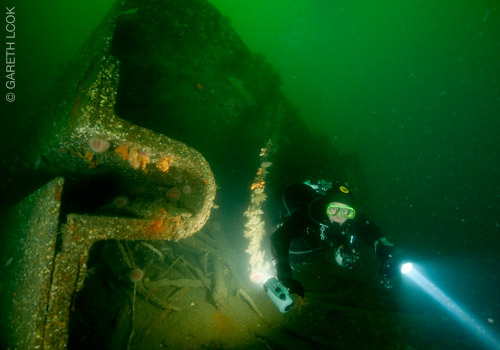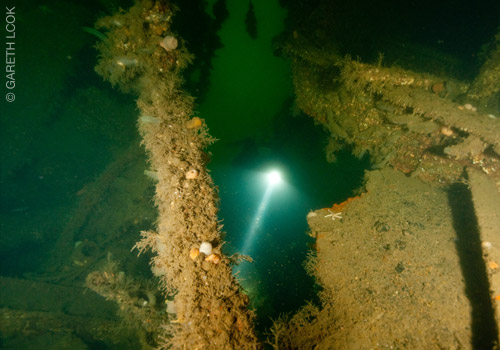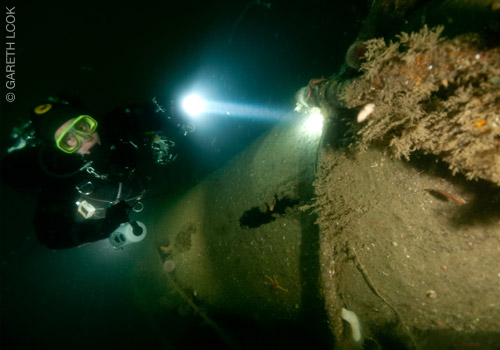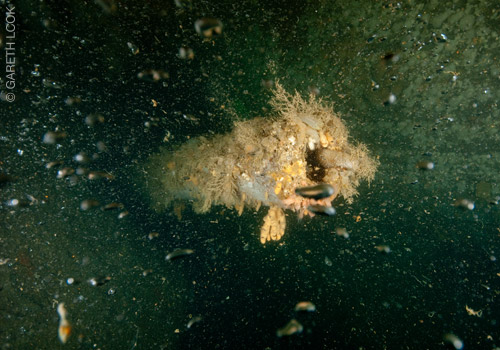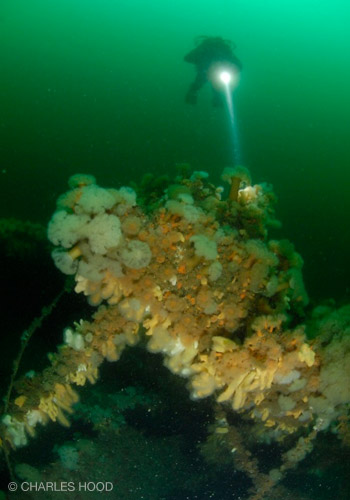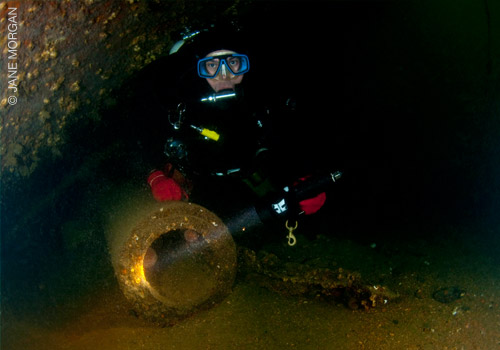Diving the SMS Kronprinz Wilhelm wreck
The Kronprinz Wilhelm is often the first of the three battleships that people dive as she is the shallowest: the top of hull is in 12 metres of water but most of the interesting features are deeper, below 30 metres, making her a good 35-metre dive well within the grasp of a competent sports divers on an average scuba set-up.
Remarkably, half of the ship’s complement of 12 inch guns are still visible and accessible: they offer a significant and unique opportunity to see the main armament of a dreadnought-era battleship. There are few other places in the world where guns of this class remain accessible to sport divers.
As a trio - Kronprinz Wilhelm, König and Markgraf - the battleships hold the most nourishment for divers but due to their size, complexity and orientation they require a number of dives and homework to decipher. For this reason they often leave divers cold on the first few dives as, without a knowledge of where to go and what to see, they can appear as an impenetrable mass of twisted steel plates. However the Kronprinz offers a good first step down the road of that understanding and opens the door on the other battleships.
Forward section and guns
The Kronprinz Wilhem has lost much of her structure around the bow section. Nevertheless, the sense of scale upon approaching the bow leaves a significant first impression. The stem curves up toward the keel and the tip of the hull, while the hull itself is characterised by two massive hawse pipes.
Considerable damage is evident here. The anchor chain is wrapped around the port barrel of the A-turret which is exposed because the gun house roof has been lost.
The Kronprinz Wilhelm, like her sister battleships, had torpedo rooms running transversely across its hull and forward of the armoured citadel. The torpedo rooms contained valuable non-ferrous metal – hence the salvage teams interest in this area. Blasting has damaged the forward wall of the armoured citadel, exposing a massive curve of metal 12-inches thick.
The mast sticks out from under the ship aft of this break. The spars and rigging are enormous, the centre of the mast has rungs to allow sailors to ascend. At the very highest point lies the spotting top, a crow's nest that would have housed seamen watching where shells dropped and feeding information back to correct the range of the firing guns.
Along the side of the ship the armoured plates have been removed. At 12-inches thick and taller than a man, these plates were important in maintaining the structure of the hull at the point where it meets the deck. As such, the outermost section of the deck has swung down and now sits in a vertical orientation.
The Kronprinz Wilhelm has retained many of her casemate guns. The forward five lie on the seabed and, although some are slightly obscured by wreckage, they do remain visible and recognisable. Two of the aft guns can be found overhead. These are often missed as the overhanging deck obscures them, but they are obvious if you know where to look.
Stern and big guns
Visiting the two gun turrets at the stern of the Kronprinz Wilhelm is undoubtedly the most popular dive on this wreck. The shot line is maintained in the same position so that divers can drop down from the end of the line and swim under the overhanging hull.
Once under the hull it is clear that one of the gun turrets is mounted slightly higher than the other in what is known as a ‘superfire’ arrangement (the top gun could fire over the bottom). The barrels of the superfiring turret are almost completely buried in the silt, although the muzzle of one gun remains clear. The two barrels from the aft turret project back toward the stern. The deck is collapsing here in parts – the teak planking has snapped due to the force of the metal above.
Moving to the outside of the hull the rudders appear twisted and bent due to the explosions from the salvage operations. However, the rudders are still recognisable and it is now possible to look into the rudder rooms at the base of each rudder. The scale of the engineering is quite incredible.
Overall, the stern section is quite small in comparison to the rest of the ship and the lines on the Kronprinz Wilhelm still show her beauty and the skill of her designers. The overall shape and structure of the ship is more obvious here, thanks to this area being more lightly armoured. Around the midship heavy armour has created a more solid and angular structure.
The top of the hull is largely intact and sits in just 12 metres of water. Thanks to greater light penetration in shallower water the hull has become inhabited by an array of marine life.
The Kronprinz Wilhelm has much to deliver and can be dived repeatedly without ever growing stale. In contrast to the Markgraf, this wreck is accessible to those without experience in technical diving and offers a unique and exciting chance to witness a magnificent battleship. Despite being immersed for nearly a century and having been at the mercy of the salvage teams, the Kronprinz remains an imposing wreck.
Wrecks Protected Status
In recognition of their historical and cultural importance, the wrecks of the Cöln, Dresden, Brummer, Karlsruhe, Kronprinz Wilhelm, König and Markgraf have been protected as scheduled monuments. Divers are welcome to enjoy and respect these wrecks but removal of artefacts from them is illegal. For more information, please visit the: MCA Website




